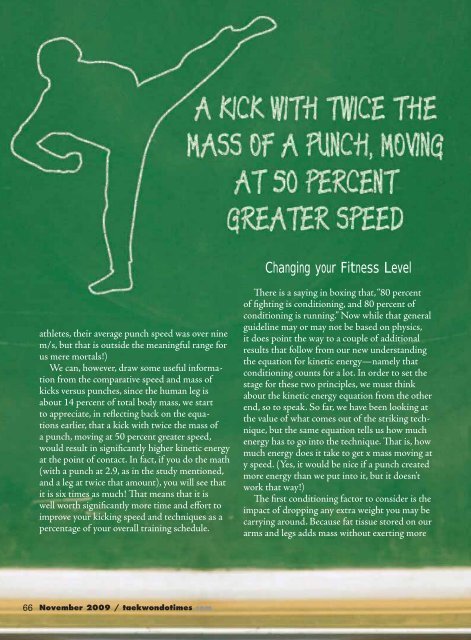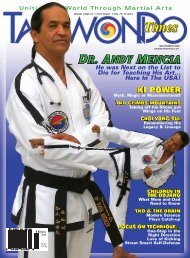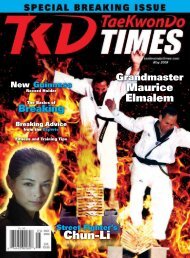Grandmaster Ken MacKenzie - Taekwondo Times
Grandmaster Ken MacKenzie - Taekwondo Times
Grandmaster Ken MacKenzie - Taekwondo Times
Create successful ePaper yourself
Turn your PDF publications into a flip-book with our unique Google optimized e-Paper software.
Changing your Fitness Level<br />
athletes, their average punch speed was over nine<br />
m/s, but that is outside the meaningful range for<br />
us mere mortals!)<br />
We can, however, draw some useful information<br />
from the comparative speed and mass of<br />
kicks versus punches, since the human leg is<br />
about 14 percent of total body mass, we start<br />
to appreciate, in reflecting back on the equations<br />
earlier, that a kick with twice the mass of<br />
a punch, moving at 50 percent greater speed,<br />
would result in significantly higher kinetic energy<br />
at the point of contact. In fact, if you do the math<br />
(with a punch at 2.9, as in the study mentioned,<br />
and a leg at twice that amount), you will see that<br />
it is six times as much! That means that it is<br />
well worth significantly more time and effort to<br />
improve your kicking speed and techniques as a<br />
percentage of your overall training schedule.<br />
There is a saying in boxing that, “80 percent<br />
of fighting is conditioning, and 80 percent of<br />
conditioning is running.” Now while that general<br />
guideline may or may not be based on physics,<br />
it does point the way to a couple of additional<br />
results that follow from our new understanding<br />
the equation for kinetic energy—namely that<br />
conditioning counts for a lot. In order to set the<br />
stage for these two principles, we must think<br />
about the kinetic energy equation from the other<br />
end, so to speak. So far, we have been looking at<br />
the value of what comes out of the striking technique,<br />
but the same equation tells us how much<br />
energy has to go into the technique. That is, how<br />
much energy does it take to get x mass moving at<br />
y speed. (Yes, it would be nice if a punch created<br />
more energy than we put into it, but it doesn’t<br />
work that way!)<br />
The first conditioning factor to consider is the<br />
impact of dropping any extra weight you may be<br />
carrying around. Because fat tissue stored on our<br />
arms and legs adds mass without exerting more<br />
66 November 2009 / taekwondotimes.com













